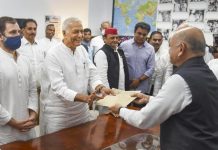 The situation along the Line of Actual Control in eastern Ladakh remains grim with no end in sight to the over three month old India-China border standoff. The Chinese People’s Liberation Army has dug in its heels at the Finger 4 area along the Pangong Tso lake and in the Depsang Plains after initially implementing a pull-back at the Galwan Valley last month.
The situation along the Line of Actual Control in eastern Ladakh remains grim with no end in sight to the over three month old India-China border standoff. The Chinese People’s Liberation Army has dug in its heels at the Finger 4 area along the Pangong Tso lake and in the Depsang Plains after initially implementing a pull-back at the Galwan Valley last month.
India, which is angry with the PLA’s behaviour has clearly told China that it will not settle for anything less than full disengagement. The face-off that started in April has left the Indian security establishment wondering how to tame China whose LAC transgression in eastern Ladakh certainly smacks of a bigger plan to grab Indian territory and alter the de facto border. The move aims to assert China’s super power dreams and comes amidst a realization in Beijing that only India has the capacity in Asia to counter the Asian giant.
Though there have been several transgressions by the PLA along the LAC over the past years, the nature of aggression this year has been unprecedented and led to the deadly clashes between the two armies in the Galwan Valley on June 15 which left 20 Indian soldiers dead and reportedly took the lives of around 40 PLA troops though China is silent over the matter.
That single incident has been responsible for sinking the trust between the two countries made India realize that it now needs to completely recast its China strategy. That recast is easier said than done though the Indian government has taken some tough steps like banning over 100 Chinese apps over charges of data security, barring Chinese companies from participating in infrastructure projects, changing FDI rules to curb Chinese investments ad is even examining the validity of several Chinese educational institutes operating in India. Perhaps, more steps are in store.
But Chinese engagement with the Indian economy happened over decades during which the Indian security establishment could not gauge the nefarious designs of the Asian dragon and to simply reverse that process to minimal levels is not possible overnight.
Therein lies the predicament being faced by the Narendra Modi government which has realized the China problem but is still in the process of working out an entirely new policy paradigm to deal with a hostile neighbour which keeps singing friendship songs just to deflect attention.
This situation has given an opportunity to the opposition Congress party to pick holes in the government’s China policy given several flip-flops since the PLA troops unilaterally violated the LAC in early May.
For instance, PM Modi told the Opposition leaders there was no incursion in eastern Ladakh but then visited Leh to charge up the Indian soldiers and deliver a stern warning to the Chinese that “the age of expansionism was over.”
Recently, the ministry of defence put out a document on its website acknowledging PLA incursions in eastern Ladakh but pulled it out later.
While Chinese apps have been banned, several mobile phone brands from that country continue to operate in India. The Congress party too has consistently questioned contributions from several Chinese companies to the PMCARES fund the government has floated to deal with the Covid-19. Also, Indian pharmaceutical companies depend on Chinese imports.
There has been no government response to these complex issues though a lot of brainstorming is going on to counter China now and in the future. A long-term China strategy will depend on India’s economic strength as well its defence preparedness. Given the government’s huge focus on dealing with Covid-19 and bringing the economy back on track, any armed conflict is undesirable though it may be unavoidable.
India’s strategy right from the beginning of the border standoff has been to talk peace but also flex military muscle to show to China that while India wants a peaceful resolution of the border crisis, it is fully prepared to protect the country’s sovereignty, if needed.
Though there have been several rounds of diplomatic and military level talks between the two countries to diffuse tension, the July 5 conversation between the two Special Representatives on the India China border issue, India’s National Security Adviser Ajit Doval and Chinese foreign minister Wang Yi, has become a reference point for the Indian strategists who have made it clear to their Chinese interlocutors that nothing short of a mutually-agreed full disengagement along the LAC was acceptable to them and that it was up to China to take corrective steps if it wanted bilateral relations to grow.
The Chinese policy over the LAC faceoff with India has been two-pronged so far. While Beijing has been talking peace, the conduct of PLA commanders on the de facto border is anything but friendly.
A classical example of the Chinese double speak was its foreign ministry recently making a confusing remark that the process of disengagement was almost complete along the border prompting India to hit back saying a lot of work was still to be done.
The process of pull back had started after the July 5 talks between the two Special Representatives but it soon hit a roadblock as China started throwing some unrealistic bargains during the military level talks, which the Indian side has refused to buy.
India has matched troops with the People’s Liberation Army deployments along the LAC since May and has asked the Army to be prepared for any eventuality. Both the sides have deployed around 30,000 troops each along the LAC in a confrontation which has
worried the world powers.
At the highest levels of the Indian security set up, the China Study Group, which has Doval and external affairs minister Dr S Jaishankar as its members, has reviewed the bottlenecks in the disengagement process and drawn contingency plans.
China, which is testing the Indian government’s nerves, has also been trying to prick the South-Asian country by raising the Kashmir issue at the United Nations Security Council. Thankfully, for India the member states have seen through this game and have refused to back China.
“We have noted that China initiated a discussion in the UN Security Council on issues pertaining to the Indian Union Territory of Jammu & Kashmir. This was not the first time that China has sought to raise a subject that is solely an internal matter of India. As on such previous occasions, this attempt too met with little support from the international community. We firmly reject China’s interference in our internal affairs and urge it to draw proper conclusions from such an infructuous attempt,” India’s ministry of external affairs said in a statement.
Interestingly, China’s move came at a time when the Indian government was celebrating the first anniversary of Union Territory Jammu and Kashmir after the Modi government scrapped Article 370 of the Constitution last year. As part of the exercise, the erstwhile state of J&K was bifurcated and besides J&K, Ladakh too became a Union Territory.
For China this move was a threat along with aggressive pursuance of border infrastructure in eastern Ladakh and the Asian dragon saw the decision as India’s plan to question China’s illegal territorial claims in Aksai Chin in the Ladakh region.
The Chinese foreign ministry also questioned India’s move to alter the status of J&K, saying the South-Asian country’s unilateral changes were “illegal and invalid”. A furious India asked China to keep off the internal affairs of other countries but is prepared for such provocations in the future.
At China’s instigation, Pakistan too has decided to protest India’s move to the change of J&K status and has even allowed construction work to start in a China-backed 4500 MW Diamer-Bhasha dam in Pakistan-Occupied Kashmir areas of Gilgit-Baltistan, whose legal status has been questioned by India.
India so far has refused to accept Pakistan rights in the controversial Gilgit-Baltistan region and has claimed that the entire areas illegally occupied by Pakistan were integral parts of India.
“The entire UT of J&K and Ladakh have been our and will be an integral and inalienable part of India. We have protested strongly against construction of this dam to the Pakistan government. This dam will lead to submergence of a large part of land in Indian UTs J&K and Ladakh,” India’s external affairs ministry spokesperson Anurag Srivastava had said.
“We condemn the continuous attempts by Pakistan to bring about material changes in Indian territories under its illegal occupation. We have also consistently conveyed our protest and shared our concern with both China and Pakistan on all such projects in Indian territories under Pakistan illegal occupation where it has no locus standi.”
letters@tehelka.com













